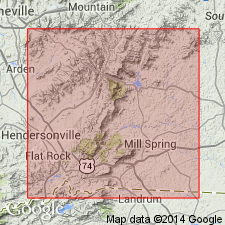
- Usage in publication:
-
- Sugarloaf gneiss
- Modifications:
-
- First used
- Dominant lithology:
-
- Gneiss
- AAPG geologic province:
-
- Piedmont-Blue Ridge province
Summary:
Davis (1993: Univ. of TN, Ph.D. dissertation) redefined the lithostratigraphy of the Columbus Promontory to include four major units including the Henderson Gneiss, the Sugarloaf gneiss, the Poor Mountain Formation, and the Mill Spring complex. New framework is consistent in many ways with original ideas of Lemmon (1973: Univ. of NC, Ph.D. dissertation). These units comprise three thrust sheets. The Sugarloaf Mountain thrust sheet includes the Sugarloaf gneiss, the Poor Mountain Formation, and the upper Mill Spring complex. The Sugarloaf gneiss is confined to the top of Sugarloaf Mountain in the Bat Cave quad. It is the structurally highest unit in the Columbus Promontory. Rocks were originally included in the Sugarloaf Mountain group by Lemmon (1973) and interpreted to be a recycled sedimentary unit, though he did not rule out an igneous origin. Because of this possible igneous origin, it is redefined by author as a separate lithologic unit. The Sugarloaf is granitic to granodioritic in composition and contains predominantly microcline, plagioclase, biotite and muscovite with zircon, sphene, apatite, allanite, chlorite, epidote, and garnet as accessories. Rock is light gray to white massive to well foliated, and contains a pronounced NE-SW mineral lineation. A similar group of unnamed gneiss bodies in the Chauga belt of SC has an Rb-Sr age of 423 Ma and both units overlie the Poor Mountain Formation. [Rb-Sr isochron age of 300+/-2 Ma determined by Goldberg and Fullagar (p. 105-107, this volume), but more study is needed to confirm this preliminary Alleghanian metamorphic age.]
Source: GNU records (USGS DDS-6; Reston GNULEX).
For more information, please contact Nancy Stamm, Geologic Names Committee Secretary.
Asterisk (*) indicates published by U.S. Geological Survey authors.
"No current usage" (†) implies that a name has been abandoned or has fallen into disuse. Former usage and, if known, replacement name given in parentheses ( ).
Slash (/) indicates name conflicts with nomenclatural guidelines (CSN, 1933; ACSN, 1961, 1970; NACSN, 1983, 2005, 2021). May be explained within brackets ([ ]).

